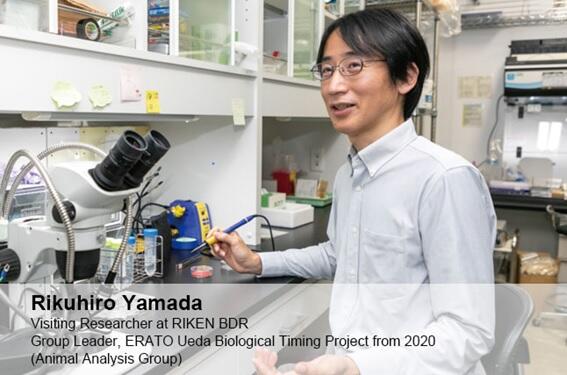Interest in sleep research has increased in recent years. The ERATO 'Ueda Biological Timing Project,' launched in October 2020, involves three sleep-research groups as well as the 'Children Sleep Checkup Project,' which analyzes and proposes guidelines for healthy sleep in children. JST News interviewed four individuals about the current state and future prospects of sleep research: Professor Hiroki Ueda of the Graduate School of Medicine at the University of Tokyo, who oversees the research (Research Director of the Project), Visiting Researcher Rikuhiro Yamada at the RIKEN Center for Biosystems Dynamics Research (RIKEN BDR), and Lecturer Koji L. Ode and Project Lecturer Akifumi Kishi of the Graduate School of Medicine at the University of Tokyo.
Measurement and analysis of genetically modified mice: Reading 'sleep phenotypes' with respiratory waveforms

Sleep measurement without implanted electrodes: Measuring data from up to approximately 1,000 mice per week
Biological phenomena, including sleep, result from the interplay of many cells and genes, and genes that play a particularly crucial role in sleep have already been identified. All living organisms, from humans to flies and nematodes, sleep. However, the mechanism underlying it remains unknown, and even the significance of sleep itself remains a mystery. The Animal Analysis Group is responsible for verifying the causal relationship between genes and sleep. They employ mice as model organisms to unravel the 'sleep phenotypes' of genetically modified mice, including sleep duration and stability.
The Group is led by Visiting Researcher Rikuhiro Yamada at RIKEN BDR. "Our ultimate goal is to measure and analyze sleep in mice, which, like humans, are mammals, and to integrate our findings with those of other Groups in order to conduct research on human sleep," he stated. The premise of sleep research is the phenomenon known as the 'biological clock.' Sleep and wakefulness involve mechanisms in which consciousness is switched on and off, and genes related to the biological clock have already been discovered. Although genetic similarities exist, sleep is more complex and requires elucidation of information transmission between neurons in the brain.
Genetic modification in which a specific gene is modified or knocked out to observe the resulting phenotype is called 'reverse genetics.' To create genetically modified animals, Yamada uses the 'Triple CRISPR method' and the 'ES mouse method.' These techniques allow the creation of mice in which necessary genes are removed from nearly all cells of the body within a single generation, without the need for crossbreeding of the animals. This is a continuation of the technological advancements achieved through communication among researchers at RIKEN BDR.
Additionally, to analyze sleep in genetically engineered mice, the 'Snappy Sleep Stager (SSS) system' is utilized. This system measures sleep by capturing the waveform of the mouse's breathing, eliminating the need to surgically implant electrodes into the skull or musculature, which has been required for conventional brain wave measurements (see Figure). Yamada scaled up the system developed by Team Leader Genshiro Sunagawa of the Laboratory for Hibernation Biology at RIKEN BDR, an alumnus of the laboratory, by four to five times. Measurements and experiments using small animals, such as mice, are within the scope of the life science field. However, an informational analysis system is essential for processing the obtained data. Thus, Yamada has applied his skills to develop an animal data management system. This system enables the measurement of data from up to approximately 1,000 mice per week, without the need for surgical implantation of electrodes into the mice. Furthermore, he has developed a unique analysis system for mouse EEGs, which previously required a human operator to visually observe and analyze the waveforms.
Figure: Snappy Sleep Stager (SSS) mouse sleep analysis

Based on the respiration patterns, sleep/wakefulness analysis can be fully automated.
Not restricted by the boundaries of his field and developing his own skills
According to Yamada, his background is in information science. "I was also interested in the fields of information and engineering, but systems and machines break down when the environment changes and cannot repair themselves. On the other hand, living organisms can adapt to their environment. That is what interested me." With this background, he joined the ERATO "Ueda Biological Timing Project," which aims to understand humans from the perspective of sleep and wakefulness. Going forward, he plans to conduct sleep research using a scientific approach at the level of genes and nerve substances, rather than relying on techniques based on the subjective experience of sleep. Based on these findings, he hopes to contribute to the promotion of healthy sleep and improvement of learning efficiency.
Yamada hopes that young people aspiring to become researchers will not be confined by existing department names or research fields. "I want them to discover what they want to pursue and develop skills in their own way. Having a clear understanding of the strengths and skills that they can offer, they can expand the possibilities for research that brings together experts from different fields, as it did in this Project." Yamada's quest continues, drawing from the experiences he gained while transitioning from the field of information science to that of life sciences.
(Article: Naoko Yoshimoto, Photography: Seiko Kusu)




